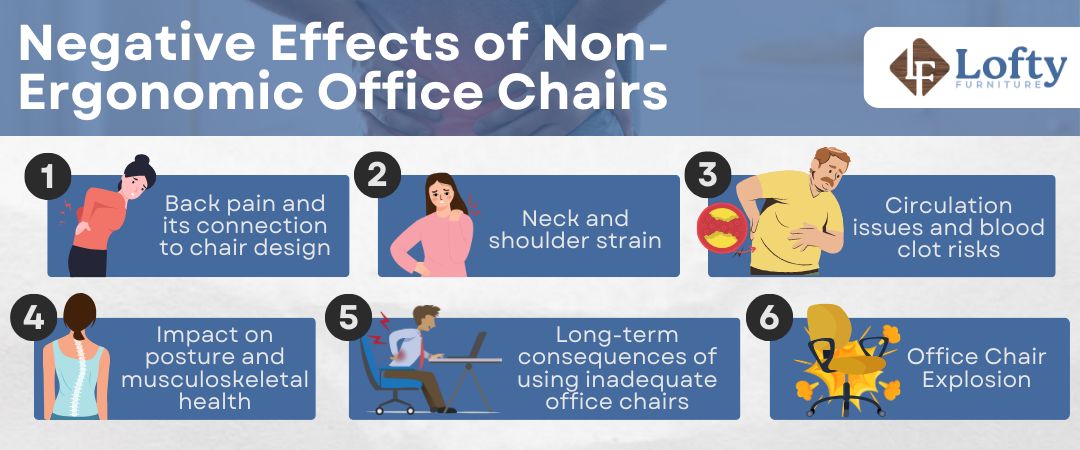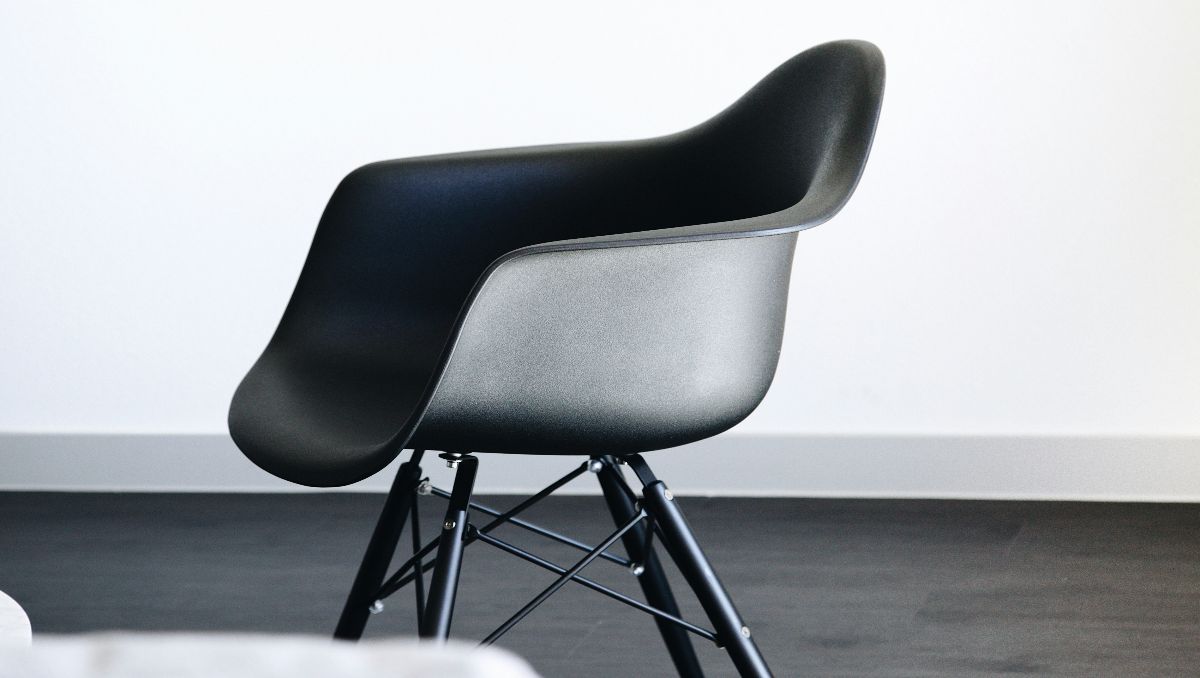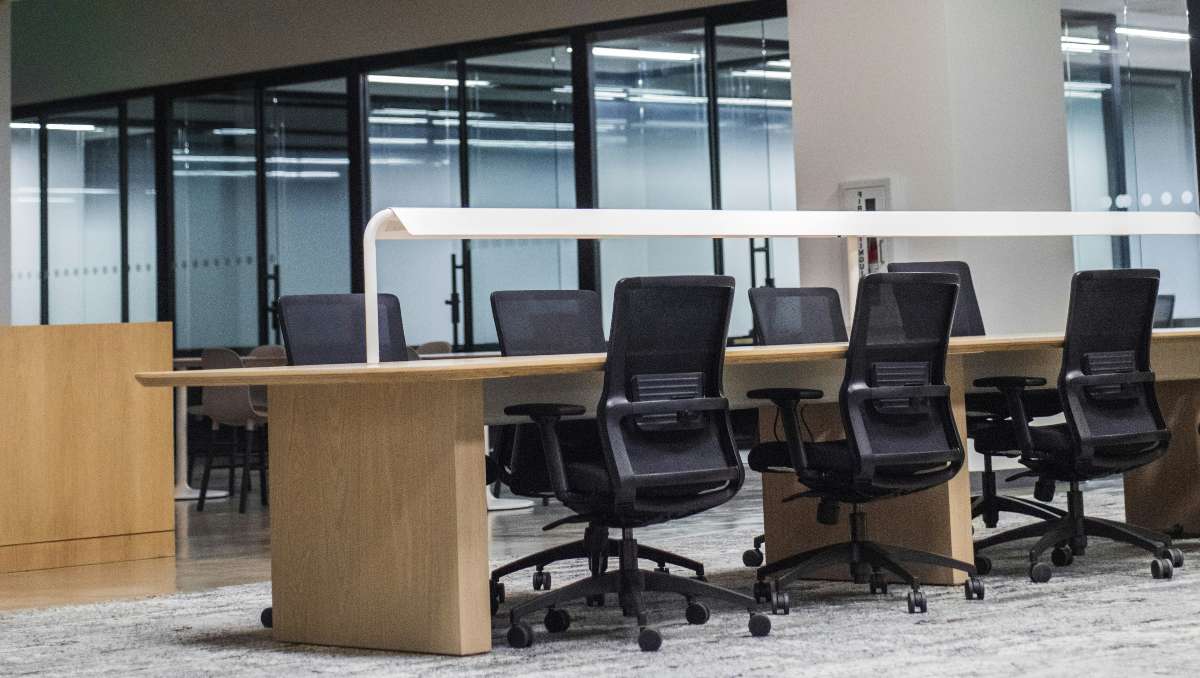Are office chairs dangerous? What if we told you that the chair you are sitting on now could be risking your health? It’s true. Office chairs, while seemingly harmless, can actually pose several potential dangers to your well-being.
Office chairs are dangerous and can pose health risks when used improperly or if they lack ergonomic design. Prolonged sitting in poorly designed chairs may contribute to back pain, neck strain, and poor posture, leading to long-term musculoskeletal issues.
In this article, we will explore the topic of office chair safety and provide valuable information on mitigating these risks.
The Ergonomics of A Good Office Chair

When it comes to the ergonomic benefits of office chairs, one of the critical factors to consider is sitting posture. A good office chair should promote proper spine alignment, keeping it in its natural S-shaped curve. This helps reduce strain on your back and neck, preventing discomfort and potential long-term injuries.
Another essential feature to consider is lumbar support. A high-quality office chair will have adjustable lumbar support that can be customized to fit your unique body shape. This ensures that your lower back is adequately supported, reducing the risk of developing chronic pain or conditions such as sciatica.
Adjustable features are also crucial for achieving optimal seating comfort. Look for a chair with adjustable armrests, seat height, and tilt mechanism. These features allow you to customize the chair according to your preferences and body proportions, ensuring maximum daily comfort.
Incorporating these ergonomic elements into an office chair promotes physical well-being and enhances productivity by providing a comfortable work environment. So next time you shop for an office chair or evaluate your current one, remember these aspects to ensure you get all the ergonomic benefits possible.
Potential Dangers Associated with Office Chairs
Office chairs can pose potential dangers to your health in several ways. The design of the chair, specifically its impact on your back, can contribute to chronic back pain.

1. Back Pain and its Connection to Chair Design
The design of office chairs is crucial in preventing back pain and supporting the lumbar region.
Chair features such as proper back support, adjustable armrests, and seat cushioning are essential to maintaining good posture and reducing stress on the spine. A chair with inadequate lumbar support can cause discomfort and strain on the lower back, leading to chronic pain over time.
Research shows that chairs with adjustable lumbar support significantly decrease the risk of developing back problems. Investing in an ergonomic chair that provides adequate support can substantially improve your sitting experience, reduce the chances of developing back pain, and promote overall well-being while working.
2. Neck and Shoulder Strain
After sitting in a chair with poor lumbar support for an extended period, you may experience strain in your neck and shoulders. This discomfort occurs because when the lower back is not properly supported, it often leads to slouching or hunching forward. This puts extra pressure on the neck and shoulder muscles.
To prevent this issue, it is crucial to implement ergonomic solutions. Start by adjusting your chair, so it provides proper lumbar support. Additionally, maintaining good posture is vital. Sit straight with your feet flat on the floor and relax your shoulders.
Incorporating stretching exercises into your daily routine can also help relieve tension in the neck and shoulder area.
3. Circulation Issues and Blood Clot Risks
Sitting for long periods can be a ticking time bomb for your health, as stagnant blood flow from poor circulation increases the risk of blood clots forming in your legs.
This is especially concerning when it comes to office chairs, which often contribute to sitting hazards. To prevent deep vein thrombosis and improve circulation, there are some steps you can take.
Make sure to stand up and move around every 30 minutes or so. This simple act will get your blood flowing and help prevent clot formation. Incorporating stretching exercises into your daily routine can promote healthy circulation.
4. Impact on Posture and Musculoskeletal Health
Improper posture and neglecting musculoskeletal health can lead to discomfort and hinder your overall well-being. It is important to be aware of the impact of office chairs on your posture and musculoskeletal health.
Poor seating positions, such as slouching or leaning forward, can strain your back, neck, and shoulders. This can cause muscle imbalances, leading to pain and stiffness. To prevent these issues, practicing good posture while sitting in an office chair is crucial.
Regarding preventative measures, following ergonomic guidelines for office chairs is essential. Workplace wellness programs that promote physical activity and educate employees about proper ergonomics are beneficial for maintaining musculoskeletal health.
5. Long-term Consequences of Using Inadequate Office Chairs
If you’ve been experiencing discomfort while sitting in your office chair, addressing it sooner rather than later is important. The long-term consequences of using inadequate office chairs can significantly impact your overall health and well-being.
Research has shown that prolonged sitting in uncomfortable chairs can lead to musculoskeletal disorders, such as back pain, neck pain, and shoulder stiffness. These issues can become chronic over time, affecting your productivity and quality of life.
A major report by Leeds Metropolitan University shows an uncomfortable office chair might cause mental health problems.
An office specialist, Louise Shipley, said:
“Workplace ergonomics plays a major role in enabling employees to perform their function to the best of their ability. Businesses must recognize these facts and take steps to ensure this doesn’t affect their physical and mental health or productivity.“
6. Office Chair Explosion
The term “office chair explosion” might conjure up images of dramatic incidents, but it actually refers to a rare yet potential safety hazard associated with office furniture. Office chairs equipped with a gas lift cylinder to facilitate height adjustments can pose a risk of malfunction, leading to unexpected incidents.
Some office chairs typically utilize a gas lift cylinder, a pneumatic device responsible for adjusting the chair’s height. This cylinder contains compressed gas, usually nitrogen, which, when functioning correctly, allows for smooth and controlled adjustments. However, if the cylinder is compromised, it can result in an uncontrolled pressure release, leading to an incident commonly referred to as an office chair explosion.
Preventing office chair explosions requires a proactive approach to chair safety. Regular maintenance checks involve inspecting the gas lift cylinder for leaks, damage, or unusual noises. Adhering to weight capacity guidelines is crucial, and users should be educated about the potential risks.
Factors Influencing Office Chair Safety
When it comes to office chair safety, several factors can influence the level of risk. One key aspect is the quality and design of the chair itself.

Chair Quality and Design
High-quality designs can significantly enhance the comfort and safety of office chairs. When it comes to chair comfort, durability factors play a crucial role. High-quality office chairs are designed with materials that can withstand daily use and provide long-lasting support.
The selection of materials is carefully considered, ensuring that they are comfortable and resistant to wear and tear. Additionally, the price range of these chairs may vary depending on the quality and features offered.
Customer reviews can provide valuable insights into the overall satisfaction and performance of different chair designs. It is crucial to consider comfort and safety when selecting an office chair, as they can significantly impact your productivity and well-being in the workplace.
Personal Habits and Practices
Personal habits and practices play a crucial role in avoiding the dangers associated with office chair use. Firstly, taking regular breaks to stand, stretch, and move around can help alleviate the strain on muscles and joints caused by prolonged sitting.
Maintaining good posture, with the back properly aligned and supported, is essential to prevent back and neck pain. Adjusting the chair to one’s specific ergonomic needs, such as seat height and lumbar support, ensures a comfortable and health-conscious sitting position.
Employing relaxation techniques and mindfulness to reduce stress can further improve overall well-being.
Workspace Ergonomics
To create a comfortable and efficient workspace, make sure to prioritize ergonomic design and setup. Your workspace setup plays a crucial role in your overall well-being and productivity.
Follow these ergonomic guidelines to discover the best way to sit and optimize your workstation:
- First, adjust your chair height so that your feet are flat on the floor and your knees are at a 90-degree angle.
- Maintain proper posture by sitting straight with your back supported by the chair’s backrest.
- Avoid slouching or leaning forward for extended periods.
- Remember to take regular breaks from prolonged sitting to stretch and move around.
Additionally, consider using ergonomic tools such as an adjustable keyboard tray or a monitor stand to position these items at eye level for better ergonomics.
How to Make Your Office Chair Safe
Regarding office chair safety, there are several vital points to keep in mind. Following these tips will help ensure a safe and comfortable work environment.
1. Choose the right office chair.
Although it may seem mundane, finding the perfect office chair can make a difference in your overall well-being.
First and foremost, proper posture is essential for maintaining good spinal alignment and reducing strain on your back. Look for chairs that offer lumbar support, which helps keep your spine’s natural curvature.
Adjustable armrests are crucial for supporting your arms comfortably, preventing shoulder and neck tension. Additionally, opt for a chair with seat height adjustment to position yourself at the optimal height relative to your desk.
By selecting an office chair that incorporates these features, you can significantly improve your comfort and reduce the risk of developing long-term health issues associated with prolonged sitting.
2. Adjust your office chair properly.
Adjusting your office chair properly ensures that you are sitting in a position that supports good posture and reduces strain on your back.
Start by adjusting the seat height, lumbar support, and armrest position to achieve proper posture. Pay attention also to the chair tilt. The tilt mechanism allows you to lean slightly backward or forward, depending on your preference. Find a comfortable tilt angle that supports both relaxation and productivity.
By making these adjustments, you can create an ergonomic workstation that promotes good posture and decreases strain on your body throughout long workdays.
3. Identify and fix any chair-related issues.
A comfortable and supportive office chair is essential for a productive, pain-free work environment. However, various chair-related issues can compromise your well-being and overall work experience.

Recognizing and addressing these problems promptly is crucial for maintaining a healthy workspace. These chair-related issues include:
Worn-out or Inadequate Padding
Over time, the padding in office chairs can wear down, leading to discomfort and poor support. It is a clear sign of worn-out padding if your chair feels less cushioned or sagging in certain areas. To address this, consider investing in a quality seat cushion or backrest. These accessories can provide additional support and comfort, revitalizing your chair and making your work hours more enjoyable.
Broken or Malfunctioning Adjustments
Proper adjustments are vital to achieving an ergonomic sitting position. When chair adjustments are broken or malfunctioning, it can lead to poor posture and an increased risk of musculoskeletal issues. Regularly check and test the various adjustments on your chair, including seat height, lumbar support, and armrests. If there is any malfunctioning component, troubleshoot or seek professional assistance to repair or replace the faulty parts.
Poor Quality Materials
Chairs made from inferior materials can be a source of discomfort and pose long-term health risks. Common issues with poor-quality materials include peeling upholstery, unstable frames, and rapid wear and tear. When purchasing an office chair, prioritize high-quality materials such as sturdy metal or reinforced plastic for the frame and durable, breathable fabric for upholstery.
Lack of Mobility or Swivel Functionality
A chair’s mobility is essential for easy maneuvering and reaching different areas of your workspace without straining. If your chair lacks smooth mobility or swivel functionality, it can hinder your ability to access your desk or collaborate with colleagues effectively.
Also check for any obstructions or debris that might impede the chair’s movement. Lubricate wheels and joints regularly, and if problems persist, consider consulting with a professional to address issues related to the chair’s base or casters.
4. Create a Healthy Sitting Routine
To maintain a healthy sitting routine, you need to establish a regular schedule of movement breaks and incorporate stretching exercises to keep your body in tip-top shape.
Taking regular breaks throughout the day is also crucial. Stand up, walk around, and stretch every hour or so to relieve tension and improve circulation. By incorporating these practices into your daily routine, you can minimize the adverse effects of prolonged sitting and promote a healthier lifestyle overall.
5. Use Ergonomic Accessories
Enhance your sitting experience by incorporating ergonomic accessories to support your body and provide daily comfort. Ergonomic accessories, such as lumbar cushions and footrests, can help you maintain proper positioning while seated at your desk.
In addition to using ergonomic accessories, consider incorporating alternative seating options into your routine. Swapping out your traditional office chair for an exercise ball or a kneeling chair can engage different muscle groups and promote better posture.
6. Optimize Your Workspace
Creating an optimal workspace is key to maximizing productivity and ensuring a comfortable work environment. Workspace organization plays a crucial role in creating an efficient setup. Keep your desk clutter-free with organizers and storage solutions that fit your needs.
Consider investing in a standing desk, which allows you to alternate between sitting and standing positions, promoting better posture and reducing the risk of back pain. Proper lighting is essential for reducing eye strain, so position your desk near natural light sources or use adjustable task lighting.
Ensure your keyboard is placed at a comfortable height, with your arms relaxed at 90-degree angles. Similarly, adjust the height of your monitor so that the screen is at eye level to prevent neck strain.
Legal and Occupational Health Perspectives

Workplace regulations and employee rights play a crucial role in ensuring that employers provide a safe and comfortable working environment. Failure to comply with ergonomic guidelines can lead to liability issues for employers, as they are responsible for protecting their employees from harm.
Legal implications surrounding office chairs mainly revolve around the concept of ergonomics. Ergonomic guidelines aim to optimize the design of workspaces and equipment to fit the needs of individuals, reducing the risk of musculoskeletal disorders and other injuries.
Employers must adhere to these guidelines by providing adjustable chairs with proper lumbar support, armrests, and seat height adjustment mechanisms.
Occupational health perspectives also highlight the importance of maintaining good posture while sitting for extended periods. Employers must educate their employees on correct sitting techniques and encourage regular daily breaks or stretches.
By prioritizing workplace regulations and employee rights regarding office chair usage, companies can create an environment where employees feel valued and supported in their physical well-being. Implementing ergonomic guidelines reduces liability issues and promotes overall productivity and satisfaction among workers.
Final Note on Optimal Office Chair Safety
In conclusion, office chairs can indeed pose potential dangers if they are not used correctly. However, by following proper ergonomic guidelines and taking regular breaks to stretch, you can significantly reduce the risk of developing posture and musculoskeletal problems.
Remember, your health should always come first. So take a moment to think of your office chair as a vehicle for productivity, but one that requires frequent pit stops for maintenance and adjustments along the way. Your body will thank you in the long run!


